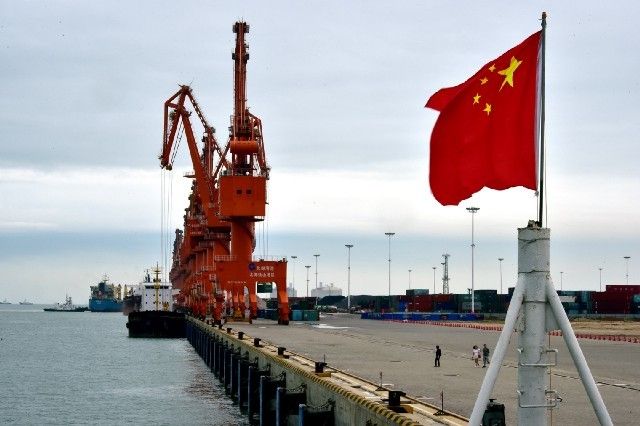After World War Two, the US used its global constellation of naval bases to expand economic and cultural power across the world. Today, China may be flipping that order on its head: establishing a global commercial and infrastructure presence that may, over time, naturally require a security component. After all, who’s going to defend trillions of dollars’ worth of Chinese rails and ports?
Remember, trade-dependent China has benefited hugely from the global naval security provided by the United States Navy. But with a US president who is tired of free riders, and a Chinese president who seeks real superpower status, it’s high stakes on the high seas in the years ahead.☰
More from GZERO Media
Hard Numbers: France’s Bardella would win an election today, Trump’s support among Latinos falls, Fox hunts for a seat in the Bahamas, and Hitler returns
November 25, 2025
Marine Le Pen, French member of parliament and parliamentary leader of the far-right National Rally (Rassemblement National - RN) party and Jordan Bardella, president of the French far-right National Rally (Rassemblement National - RN) party and member of the European Parliament, gesture during an RN political rally in Bordeaux, France, September 14, 2025.
REUTERS/Stephane Mahe
Army Chief Asim Munir holds a microphone during his visit at the Tilla Field Firing Ranges (TFFR) to witness the Exercise Hammer Strike, a high-intensity field training exercise conducted by the Pakistan Army's Mangla Strike Corps, in Mangla, Pakistan, on May 1, 2025.
Inter-Services Public Relations (ISPR)/Handout via REUTERS
Field Marshal Asim Munir, the country’s de facto leader, consolidated his power after the National Assembly rammed through a controversial constitutional amendment this month that grants him lifelong immunity from any legal prosecution.
What We’re Watching: Russia and Ukraine negotiations continue, Trump and Xi make a springtime date, Sudan’s rebels declare unilateral ceasefire
November 25, 2025
Ukraine's President Volodymyr Zelenskiy and U.S. Army Secretary Daniel Driscoll attend a meeting, amid Russia's attack on Ukraine, in Kyiv, Ukraine, November 20, 2025.
Ukrainian Presidential Press Service/Handout via REUTERS
- YouTube
In this “ask ian,” Ian Bremmer tackles a growing question: How is the Trump administration performing as the year wraps up?
- YouTube
Former US Ambassador to Venezuela James Story warns that removing Maduro would be the easy part—what comes next is the real challenge.
In this episode of Tools and Weapons, Microsoft Vice Chair and President Brad Smith sits down with Ed Policy, President and CEO of the Green Bay Packers, to discuss how purpose-driven leadership and innovation are shaping the future of one of the world’s most iconic sports franchises. Ed shares how technology and community-focused initiatives, from Titletown Tech to health and safety innovations on the field, are transforming not just the game of football, but the economy and culture of Green Bay itself. He explains how combining strategic vision with investment in local startups is keeping talent in the Midwest and creating opportunities that extend far beyond Lambeau Field.
Subscribe and find new episodes monthly, wherever you listen to podcasts.
- YouTube
In this Quick Take, Ian Bremmer breaks down the controversy around Trump's 28-point Ukraine-Russia peace plan.
Hard Numbers: Israel assassinates Hezbollah commander, DOGE gets DOGE’d, Ethiopian volcano erupts, Not much to show for COP30
November 24, 2025
People walk past a damaged building during the funeral of Hezbollah's top military official, Haytham Ali Tabtabai, and of other people who were killed by an Israeli airstrike on Sunday, despite a U.S.-brokered truce a year ago, in Beirut's southern suburbs, Lebanon November 24, 2025.
REUTERS/Mohamed Azakir
The Israeli military assassinated a senior Hezbollah commander in an airstrike on the Lebanese capital of Beirut on Sunday. The attack killed at least five people overall.
What We’re Watching: Russia-Ukraine peace deal, Rough weekend for Brazil, Mass school abductions in Nigeria
November 24, 2025
Servicemen of the 148th Separate Artillery Zhytomyr Brigade of the Armed Forces of Ukraine fire a Caesar self-propelled howitzer towards Russian troops at a position on the front line, amid Russia's attack on Ukraine, near the frontline town of Pokrovsk in Donetsk region, Ukraine November 23, 2025.
REUTERS/Anatolii Stepanov
After facing backlash that the US’s first 28-point peace deal was too friendly towards Russia, American and Ukrainian negotiators drafted a new 19-point plan on Monday.
© 2025 GZERO Media. All Rights Reserved | A Eurasia Group media company.
